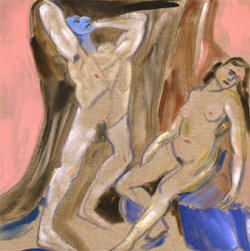Ron Kitaj
dal 21/11/2006 al 5/1/2007
Segnalato da
21/11/2006
Ron Kitaj
Marlborough Fine Art, London
Little Pictures

Little Pictures
Unlike the richly layered iconography of many of his major paintings over the last 40 years - such as "If not, not" which, in tapestry form, crowns the entrance hall to the new British Library - the Little Pictures address single fragments of his research. They are private and often intensely personal meditations on subjects or themes close to his heart. In this, they more closely resemble his encyclopaedic print portfolio "In our Time", which encapsulated in 50 single screenprinted images of 20th century book covers a personal view of the century’s ideals, strivings, fantasies, and wickedness, from Ezra Pound, via Isaac Babel, the Bauhaus and Hitler, to Henry Miller and James Agee. Kitaj’s Little Pictures now centre on Jewishness and ‘diasporism’ in general, on the memory of his late wife, the artist Sandra Fisher, who died suddenly at the age of 47 in 1994, and on Ce'zanne’s late ‘Bathers’ compositions, of which around 200 are known. This focus was already taking shape in his last London exhibition "Kitaj in the aura of Ce'zanne and other Masters" at the National Gallery in 2001.
Although born into a second generation Jewish-American family in 1932, it was only in the ‘70’s that Kitaj became concerned with the character of Jewishness and what he has termed ‘diasporism’ - the culture of individuals and communities in exile, or of minorities, or of individuals or groups with unfamiliar beliefs or values - as he was working on his then countercultural Arts Council exhibition "The Human Clay". In the midst of the fashion for Minimalism and Conceptual Art, Kitaj brought together 48 British figurative artists, headed by painters of dauntingly strong and life-long commitment to the human form - Bacon, Freud, Auerbach, Kossoff, Andrews and his close friend Hockney - which gave rise to the grouping of a ‘School of London’ affinity. This feeling of not ever being fully in step with mainstream art tendencies - of ‘stranger-ness’, as he calls it - has dogged the artist throughout his career. He once confessed "I feel unbalanced most of the time …. dislocated. There is no unmediated culture now - one is hybrid, unpure ….", and this must still be true of his chosen homeland, Los Angeles - host, alongside New York, to the greatest number of Diaspora communities from Europe, Latin America, Asia and, of course, Africa.
Through an earlier pre-occupation with turn-of-the-century intellectual life in Vienna (where he had started his art studies in the early ‘50’s), as well as an admiration for the Warburg Institute approach to the history of art-in-its-intellectual-context (since after Vienna he had moved to Oxford to study with the art historian Edgar Wind, before going on to the Royal College of Art) Kitaj has come to identify most strongly with the central European Jewish writer Franz Kafka, and with his sense of estrangement and of hidden mysteries. Illustrations to Kafka’s aphorisms, imaginary portraits of his fiance'e Felice and Count West-West who owned ‘The Castle’, appear in the Little Pictures, as do rapidly sketched portraits of Karl Kraus, Paul Celan, Leon Trotsky and Ludwig Wittgenstein, representations of Judeo-Christian mysteries of the hidden face of God, and the artist’s meditations on the Jewish Christ.
Sandra Fisher is present in several contemplative paintings of remembrance and reunion. In these works his old-age style - in homage to Ce'zanne - of patches of luminous colours, often in parallel strokes, juxtaposes the illusion of recognisable figuration with patterns of abstract decoration, oppositions which lie at the core of 20th century art practice. But although Ce'zanne is, for Kitaj, the supreme Master, the artist also pays homage in his Little Pictures to Matisse, Munch (in a luminous self-portrait in turquoise), van Gogh (in whose voluminous correspondence Kitaj detects a fellow-exegete of his own work), Klee, and to the Old Masters he most admires: Giotto, Masaccio and Michelangelo.
Deliberately sketchy and highly personal as these Little Pictures are, they offer an unmediated insight into the artist’s mind. In his own words, Kitaj has confessed that he is "a book mad old man, freethinking Jew…... a scholar only of my own pictures. I read a helluva lot for them." He has never abandoned his pre-Romantic concept of the artist-as-Humanist, who is well acquainted with the main themes of history and mythology, and able to converse with the leading intellects and patrons of his age. He understood early on how "books and art have been inseparable companions in many art lives", from Michelangelo and Vasari to van Gogh and Kandinsky. In the past, his rigorous intellectual approach has sometimes led to misunderstandings in the art world, some of whose adherents expected the artist to remain studio-bound, but also mute and unconcerned with the issues of the age. Still reluctant to conform, Kitaj now invites the public to view his self-exposure, and to judge his confessions with an open mind.
Marlborough
6 Albemarle Street - London
Free Admission



